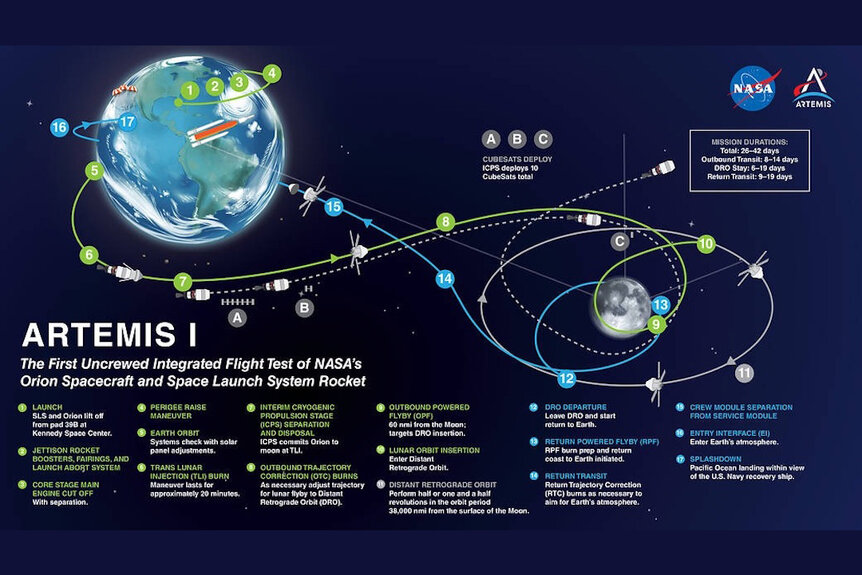Create a free profile to get unlimited access to exclusive videos, sweepstakes, and more!
A new era in space flight: NASA launches Artemis 1, our first step in returning to the moon
To the moon!

After a couple of prior launch delays, NASA’s Artemis 1 mission once again entered a launch window just after 1:00 AM Eastern time this morning. This mission is the first flight of the Artemis program which aims to return human astronauts to the Moon and establish a permanent presence there.
During preparations for launch, a leak was identified on a hydrogen valve inside the mobile launcher. A specialized team called a red crew was assembled to address the issue and launch preparations continued. There were other minor delays, including a communications issue with the mission’s abort system. It’s a built-in safety feature operated by Space Force, which would allow them to destroy the rocket in the event that it veered off course.
Moments later, that issue had been resolved and at 1:33 AM we heard that there were no constraints to launch, and polling was about to begin. Silence fell over the broadcast while we waited, and then the audio switched over to mission control. Charlie Blackwell-Thompson, launch director for the mission, began the poll, reading off each department one at a time. EGS Program Chief Engineer. EGS Chief Safety Officer. Range Weather. Mission Manager/Launch Director. Each replied, “no constrains and go for launch.”
With the final “go for launch” Blackwell-Thompson paused briefly to commemorate the moment, “On behalf of all the men and women across our great nation who have worked to bring this hardware together to make this day possible, and for the Artemis generation, this is for you.” Then the countdown began at T-ten minutes, with a launch time of 1:47 AM. Over the next ten minutes the umbilici tensed and relaxed, the engines flexed, and NASA’s SLS prepared to carry the Orion capsule beyond the Moon. By the time the mission is finished it will have set a new record for the furthest distance travelled by a human-rated spacecraft.
At 1:47 AM, right on time, Artemis 1 lifted off from Florida’s Kennedy Space Center. Moments later, the main engine cut off and Orion went into a slightly elliptical orbit around the Earth. A few minutes later the craft deployed a solar array comprised of approximately 15,000 solar cells capable of generating 11 kilowatts of power. That supplements the onboard batteries and takes the place of the power cells used during the Apollo program. About an hour into the mission, the spacecraft performed a maneuver which pushed it into a stable circular orbit. There, the craft could hang out while mission control performed tests and checks to make sure everything was operating correctly after the journey through the atmosphere.
Finally, the spacecraft initiated a translunar injection burn. During that burn, the engine fired with 24,000 pounds of thrust for 18 minutes, sending Artemis 1 on a path toward the Moon. It will take a few days for Artemis 1 to get to the Moon and the craft will get as close as 80 miles above the surface. Once there, Orion will go into a distant retrograde orbit, parking itself in a stable orbit high above the Moon’s surface.
The ship will stay there for most of the mission, where NASA will put the hardware through its paces. Because Artemis 1 is a test flight for the upcoming crewed missions, the data NASA can gather from actually having their launch system and crew compartment in space is invaluable.
The next time the spacecraft flies it will be carrying astronauts on a trip around the Moon, and the time after that we’ll put boots on the ground. Unlike Apollo, the goal isn’t to send astronauts for the equivalent of a long weekend, but to establish long-term facilities for people to live and work on the lunar surface.
The long-term goals of Artemis are a natural extension of the work being done on the International Space Station, where we have maintained an unbroken human presence in low-Earth orbit for more than two decades. To that end, NASA has identified thirteen potential landing sites around the lunar south pole where we have confirmed the presence of water ice. That water could be used for drinking or to create the fuel or oxygen astronauts will need to live on the Moon. Understanding how to utilize off-planet resources is likely to be crucial as we continue to push farther into the solar system.
When Artemis 1 is ready to come home it will perform another burn to pull it out of lunar orbit and bring it back to Earth. Once it’s back in the neighborhood, The European Service Module will separate and the crew module will break away, revealing the heat shield for the first time. Testing the heat shield is one of the most important parts of the test flight. The craft will be travelling approximately 20,000 miles per hour as it begins re-entry, heating the shield to more than 5,000 degrees. NASA is planning to skip the crew module off the atmosphere one time, to slow it down before it plunges black to Earth. Along the way, atmospheric drag will slow the capsule to about 300 miles per hour. At that point, parachutes will deploy and gently lower the Orion capsule into the ocean 26 days after this morning’s launch.
The successful launch of Artemis 1 plants humanity’s foot firmly on the path back to a human presence on the Moon. We’re really going back and it’s happening right now. You can watch the NASA live stream to keep an eye on Arty as it charts the course for the next crewed mission to the Moon.
Looking for some science fiction space adventures in the meantime? Stream SYFY's Battlestar Galactica on Peacock right now, and keep an eye out for SYFY's new original series The Ark coming in early 2023.



























